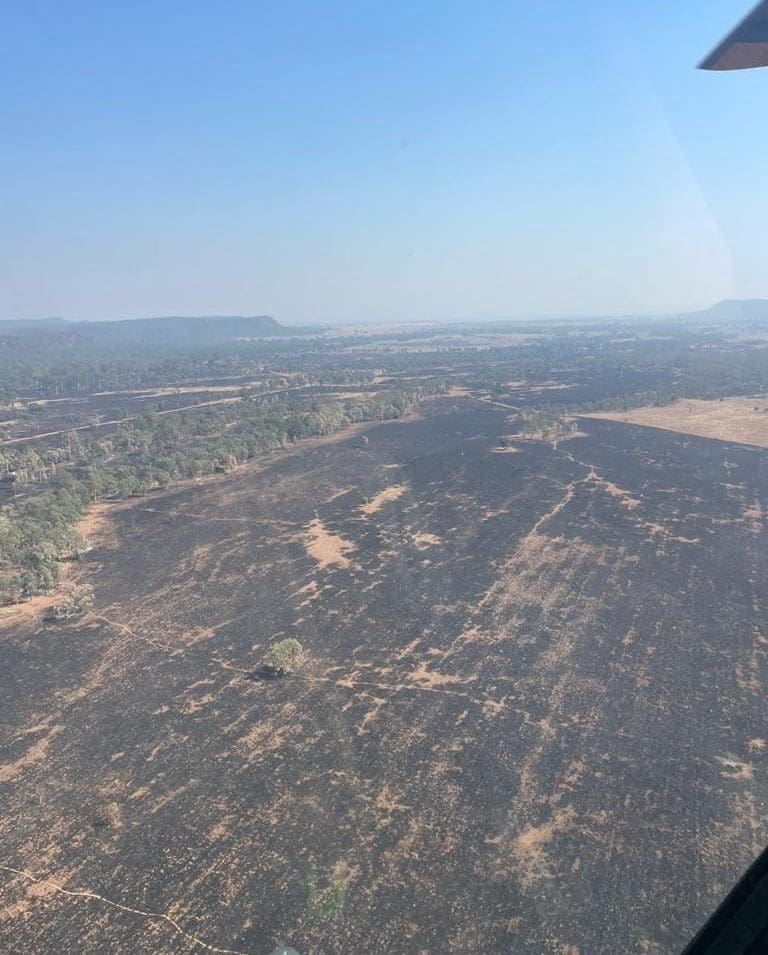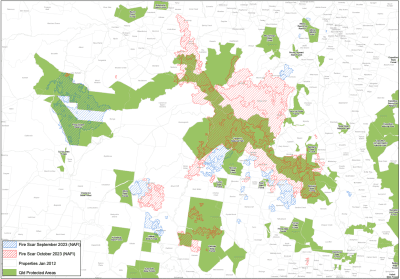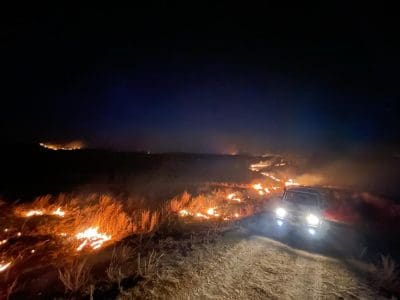THE scorched black scars from a massive blaze that burned across 430,000 hectares of Central Queensland will diminish in time, but the after effects will be felt for decades to come, landholders who battled the behemoth for over a month say.

The inferno turned vast areas of valuable grass being kept in reserve for summer into smouldering ash, leaving many animals without feed and producers with very few options to feed them, while also “burning to death” national parks, in the words of one nearby producer.
Conversations with local landholders and their representatives over the past week – wearied from more than a month of fighting fires – have highlighted concerns over the capacity of urban-based decision making frameworks to enable effective cool season burns in regional national parks and coordination with those with local knowledge and experience during rural fire responses.
For local landholder James Speed, who has used his helicopter to help with fire fighting efforts across the CQ region over the past month, the issue boils down to a key problem: a “fear of litigation” discouraging decisive action at all levels (see separate story).
Springsure megafire
It is not clear how the Springsure fire started, with the most likely scenario thought to be a lightning strike at the southern end of the Carnarvon Gorge National Park in September.

The shaded areas show total area burned from September (blue) and October (red) 2023. The total included 200,000tha of Queensland Protected Areas along with 273,581ha burnt across 62 properties. Source: AgForce. Click on map to enlarge.
But the seriousness of the monster blaze that ensued was without question, spreading into a behemoth in the National Park with a perimeter of over 800 kilometres.
AgForce Central Queensland regional manager Sara Cue, who has been working closely with local landholders in the region, said the total area burned included 205,000ha of Queensland’s Protected Areas (see map).
As the fire built up in the national park all neighbouring landholders could do was sit, wait and prepare for the fire to come out, she said, working on widening fire breaks where possible and putting in additional breaks off which to back burn.
But ultimately their efforts were futile given the intensity of the fire that emerged from the park.
“Where the fire hit on the north-eastern side of the park, a hundred-metre wide fire break wouldn’t have stopped it due to wind changes and the fuel load in the gorge,” Sara said.
After a month of day and night efforts it appears the worst of the blaze has been brought under control, with some properties receiving rain, but fires still being monitored.
During the peak, producers said they were warned by fire command officials that if they lit back burning fires to stop the blaze they would be heavily prosecuted for starting fires during a total fire ban.
Yet many also believe that if not for those who did take action to backburn, despite technically operating illegally, some homes and many more thousands of hectares of grassland would have been lost.
 Where properties have been burned out, owners now face the cost of tens or even hundreds of thousands of dollars to buy in feed to replace the grass they have lost. Others may be forced to sell valuable stock into a severely depressed market.
Where properties have been burned out, owners now face the cost of tens or even hundreds of thousands of dollars to buy in feed to replace the grass they have lost. Others may be forced to sell valuable stock into a severely depressed market.
Producers were understandably reluctant to see grass sacrificed without need.
One anecdotal report tells of CQ producers standing their ground when authorities planned to backburn 60km of roadside. Their defiance ultimately saved 12 properties from unnecessary and considerable losses.
Producers have also expressed concern that current decision-making systems prevent adequate preparation to minimise fire intensity in advance.
“Producers I spoke with rang Firecom prior to fire arriving in their region, requesting to back burn the gorge boundary, which they were refused due to protected flora and fauna.
“When the fire hit everything went up,” Sara said.
 “Only one producer I’ve spoken to was given permission to back burn two weeks prior to fire reaching their area. Thankfully they only lost a few thousand acres.”
“Only one producer I’ve spoken to was given permission to back burn two weeks prior to fire reaching their area. Thankfully they only lost a few thousand acres.”
Asked what could be done to improve future fire management, Sara said respect for local knowledge in decision-making was crucial.
“Local producer and local rural fire brigade knowledge is pivotal and should be respected, especially in larger generational holdings,” she said.
“This isn’t their first rodeo.
“All of this carnage is due to unmanaged national parks.
“In due course strong conversations need to be had from what we’ve leant by fighting this fire so it can never happen again.”
A good news story
She said the experience had also highlighted good news stories as well, such as the lengths rural community members go to help each out other out.
One example she pointed to was the Buckland Rural Fire Brigade.
“The members all have the same gear on fire fighter units so that everything is interchangeable in case of breakdowns.
“The community spirit is to be applauded, they all came together to fight a megafire that came out of Carnarvon Gorge National Park.
“By using their own equipment during this time they have saved many hundreds of thousands of hectares of grass and infrastructure.”
QFES response: Area Fire Management Groups central to bushfire planning and response
Beef Central asked the Queensland Fire and Emergency Services for its response to concerns that local knowledge was not being taken into consideration when QFES authorities take over fire management in rural areas, or that the current system does not allow for adequate cool-season controlled burns in National Parks to reduce fuel loads.
A QFES spokesperson provided the following statement in response:
 “Queensland Fire and Emergency Services (QFES) works closely with Area Fire Management Groups (AFMGs) across the state to prepare for, and respond to, bushfire threats. AFMGs include local landholder representatives as well as community, industry and government stakeholders.
“Queensland Fire and Emergency Services (QFES) works closely with Area Fire Management Groups (AFMGs) across the state to prepare for, and respond to, bushfire threats. AFMGs include local landholder representatives as well as community, industry and government stakeholders.
“Rural Fire Service (RFS) brigades, which are part of QFES and made up of dedicated community members, provide valuable local knowledge and expertise around mitigation and response strategies.
“Following a prolonged period of wet conditions, there has been vegetation growth across much of the state. What we are seeing now, even with considerable hazard reduction burns completed this year, is the type of increased bushfire activity we’ve been expecting and planning for.
“Bushfire mitigation is a joint effort between landowners, our partners and local, state and federal government. In the last two years, QFES shifted its approach to hazard mitigation. Rather than specifying a season, QFES and its partners now work on hazard mitigation activities year-round, when conditions are appropriate. This approach has allowed us to take advantage of limited windows of opportunity to conduct hazard mitigation, particularly prescribed burning.”
Meeting this week to discuss CQ fire response
Meanwhile, AgForce’s Dr Greg Leach and Sara Cue will be at the Springsure Library this Thursday, November 23 from 9am to 5pm to discuss matters of concern in the fire response by authorities, dealing with officials and learnings from recent fire events.
AgForce said it is seeking advice on solutions for coordinated fire planning and management to submit currently to Regional and State Bushfire Committees to improve outcomes for landowners.
“Through this fire season AgForce intends to engage with affected members in areas across the State where fire events have resulted in unsatisfactory outcomes, with particular focus on protection and mitigation across tenures and fire response actions. This will inform AgForce’s longer-term submissions to State and Federal governments.”
